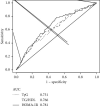Insulin Resistance Markers to Detect Nonalcoholic Fatty Liver Disease in a Male Hispanic Population
- PMID: 35966932
- PMCID: PMC9365587
- DOI: 10.1155/2022/1782221
Insulin Resistance Markers to Detect Nonalcoholic Fatty Liver Disease in a Male Hispanic Population
Abstract
Background: Nonalcoholic fatty liver disease (NAFLD) is one of the leading causes of chronic liver disease and is closely associated with cardiometabolic disorders, being insulin resistance (IR) the common pathogenic mechanism. The triglycerides/glucose (TyG) index and triglycerides/HDL-c (TG/HDL) ratio are markers correlated with IR. We compared the capacity of these two indexes, alongside IR, to detect NAFLD.
Methods: In a cross-sectional cohort study, we examined 263 active military personnel from the Colombian Air Force, aged between 29 and 54 years. Anthropometric measurements and biochemical determinations (glycemia, lipid profile, and insulin) were obtained, and ultrasound studies were performed to evaluate the presence of NAFLD. HOMA-IR index was calculated as (fasting insulin (µIU/mL) × fasting glucose (mmol/L)/22.5), the TyG index as Ln (triglycerides (mg/dL) × fasting glucose (mg/dL)/2), and the TG/HDL ratio as (triglycerides (mg/dL)/HDL-c (mg/dL)).
Results: NAFLD ultrasound criteria were met in 70 individuals (26.6%). Subjects with NAFLD had significantly higher values of HOMA-IR (2.55 ± 1.36 vs. 1.51 ± 0.91), TyG (9.17 ± 0.53 vs. 8.7 ± 0.51), and TG/HDL (6.6 ± 4.54 vs. 3.52 ± 2.32) compared to those without NAFLD (p < 0.001). A TyG cutoff point of 8.92 showed an AUC of 0.731, while cutoff points of 3.83 for TG/HDL and 1.68 for HOMA-IR showed an AUC of 0.766 and 0.781, respectively.
Conclusion: Our study shows that novel and lower-cost markers of IR are useful for detecting NALFD, with a performance comparable to the HOMA-IR index. These markers should be used as the first step when screening patients for NAFLD.
Copyright © 2022 Maritza Pérez-Mayorga et al.
Conflict of interest statement
The authors declare that there are no conflicts of interest.
Figures


Similar articles
-
Markers of insulin resistance associated with non-alcoholic fatty liver disease in non-diabetic population.Sci Rep. 2023 Nov 22;13(1):20470. doi: 10.1038/s41598-023-47269-4. Sci Rep. 2023. PMID: 37993481 Free PMC article.
-
Triglyceride Glucose Index Is Superior to the Homeostasis Model Assessment of Insulin Resistance for Predicting Nonalcoholic Fatty Liver Disease in Korean Adults.Endocrinol Metab (Seoul). 2019 Jun;34(2):179-186. doi: 10.3803/EnM.2019.34.2.179. Endocrinol Metab (Seoul). 2019. PMID: 31257745 Free PMC article.
-
Evaluation of the ability of insulin resistance and lipid-related indices to predict the presence of NAFLD in obese adolescents.Lipids Health Dis. 2024 Jul 2;23(1):208. doi: 10.1186/s12944-024-02144-7. Lipids Health Dis. 2024. PMID: 38956572 Free PMC article.
-
Understanding Insulin Resistance in NAFLD: A Systematic Review and Meta-Analysis Focused on HOMA-IR in South Asians.Cureus. 2024 Oct 3;16(10):e70768. doi: 10.7759/cureus.70768. eCollection 2024 Oct. Cureus. 2024. PMID: 39364176 Free PMC article. Review.
-
The triglyceride and glucose index and risk of nonalcoholic fatty liver disease: A dose-response meta-analysis.Front Endocrinol (Lausanne). 2023 Jan 19;13:1043169. doi: 10.3389/fendo.2022.1043169. eCollection 2022. Front Endocrinol (Lausanne). 2023. PMID: 36743937 Free PMC article.
Cited by
-
Huangqin-Huanglian Decoction Protects Liver against Non-alcoholic Fatty Liver Disease in High Fat-diet Mice.Endocr Metab Immune Disord Drug Targets. 2024;24(6):691-708. doi: 10.2174/0118715303257018230927182802. Endocr Metab Immune Disord Drug Targets. 2024. PMID: 37859322
-
Sexual Dimorphism in Impairment of Acetylcholine-Mediated Vasorelaxation in Zucker Diabetic Fatty (ZDF) Rat Aorta: A Monogenic Model of Obesity-Induced Type 2 Diabetes.Int J Mol Sci. 2024 Oct 21;25(20):11328. doi: 10.3390/ijms252011328. Int J Mol Sci. 2024. PMID: 39457110 Free PMC article.
References
MeSH terms
Substances
LinkOut - more resources
Full Text Sources
Medical
Miscellaneous

